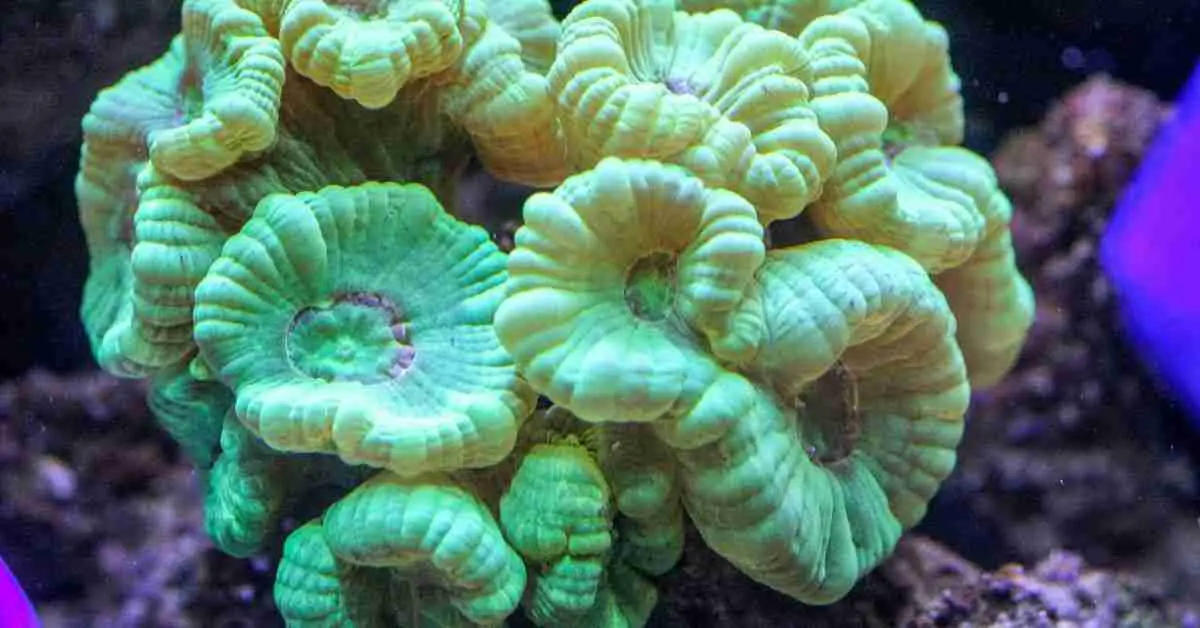Candy cane corals are quite sensitive, indeed. They may fall ill and die due to slight changes in aquarium conditions. Oftentimes, they even catch viral diseases.
When do we see our candy cane coral dying?
Firstly, we need to check the symptoms to see if it has any viral diseases. If it does, we need to throw it away asap.
If it doesn’t have any viral disease, we need to check our aquarium conditions. Conditions such as water parameters, water quality, lighting, and the presence of light are crucial to keeping in check.
Are you interested to know more about how you can fix these conditions? Then take some time to read through this whole article!
What Can Cause Your Candy Cane Coral Dying?
Factors such as diseases or unhealthy aquarium conditions are the main culprit here. Know about them in detail in the next section.
Diseases
It is quite common that they may get brown jelly syndrome. This disease causes them to release brown jelly-like discharges. Then after a few days, parts of the whole coral may dissolve.
We need to make sure that it doesn’t happen inside the aquarium. The discharges are very harmful to the whole aquarium.
Once we start seeing the brown discharges, we need to eliminate the coral.
What to do if we still have doubts or difficulty in identifying whether the discharge is due to brown jelly disease?
Even then, we should not take any risks. We should keep that coral in an isolated aquarium if we are too hesitant about disposing of it.
Aquarium Conditions
However, if the cane coral does not show symptoms, we must do other things. We need to check the aquarium conditions thoroughly.
Once we are done checking the aquarium conditions, we need to give the coral some time. It may come back to full health.
If not, leaving it in the aquarium, even after it’s dead, will help it grow some head itself. It may reproduce.
4 Conditions To Keep In Check To Stop Candy Cane Coral Dying
Keeping a healthy aquarium means ensuring the healthy life of the corals.
Corals are very sensitive to slight changes in aquarium conditions. So, we need to go the extra mile to maintain our aquarium.
Also, we cannot use a new aquarium to place our corals. We must ensure that the aquarium has been used for at least 6 months before placing the coral.
Giving it more time means that it gets to complete more cycles.
The more the number of cycles it has completed, the better. Also, before adding each new coral or livestock to the aquarium, we need to do a water change.
Now let us look at what aquarium conditions to control
Step 1 of 4: Checking The Water Parameters
4 water parameters are important to consider:
- Alkalinity: optimum level is 8-12 dkh
- Calcium: optimum level is 400-450ppm
- Salinity: optimum level is 1.023-1.025
- Magnesium: optimum level is 1250-1400ppm
Firstly, we need to check the alkalinity using test kits. If the alkalinity exceeds the recommended range, we need to lower it by adding low mineral water to dilute the solution.
If it’s below the recommended range, we need to raise it by adding baking soda to the water.
Other relevant products can also be found at pet stores that can help with the situation.
Then we need to check the calcium level using the best calcium test kits. Adding supplements would help with low calcium levels.
Water filtration to remove calcium precipitates would help with high calcium levels.
For salinity, we need to check the level using relevant test kits.
To set the salinity right, we must do a water change. 50-90% of water change can be done depending on how much the salinity is out of the recommended range.
Use magnesium test kits to check the levels first. Magnesium levels usually get down naturally within 1 or 2 days if it is within 2000ppm.
If it is beyond that, we need to take some additional steps to maintain the magnesium level. If the magnesium level is too low, we can increase it by adding supplements.
Step 2 of 4: Check The Water Quality
To check the water quality, we need to check the phosphate and nitrate levels in the water.
- Ideal phosphate level: 0.03
- Nitrate level: 10
If the phosphate and nitrate levels are right, the water quality is all good. The usage of good phosphate and nitrate kits does wonders. A wrong kit can make the whole thing 10 times harder.
If the phosphate or nitrate level is too low, we need to add supplements and do a water change. If it is too high, we need to use quality phosphate and nitrate removers.
In addition, we need to maintain a few things to not contaminate the water quality in the first place. Any lotion, oil, or other relevant residues on our hands may act as major contaminants.
Usage of any aerosols or insecticides in or near the tank should be strictly prohibited.
Step 3 of 4: Fix The Lighting
The corals would seem to be growing towards the light if the light intensity was too low. They will bend awkwardly toward the light source.
On the other hand, if the light intensity is too high, the coral will shrink away from it.
If we notice such visible symptoms, we need to fix the lighting immediately.
We should also install light bulbs to ensure the healthy growth of the corals.
Step 4 of 4: Get Rid Of Pests
This is the last step. Pests are difficult to detect. So we can do this step nonetheless. Take 1L of the water in a tank. Dissolve 1-2ml of iodine in it. Dip the candy cane coral.
Check the water thoroughly for the presence of any worms or unusual. These can cause black spots on clownfish.
Then throw the water away and place the corals back in the aquarium. Keeping the corals pest-free solves most of the problems!
FAQs
Question: Do candy cane corals flow?
Answer: Candy cane corals work best when placed in moderate lighting and with low flow.
So, place them at the bottom parts of the tank where light intensity is moderate, and water flow is minimum.
Question: How long does it take candy cane corals to grow?
Answer: Candy cane corals typically require 4 months to grow fully. Low to moderate water flow and light intensity, along with feeding them routinely, would ensure optimum growth.
Question: Are candy cane corals aggressive?
Answer: No, they are not that aggressive. Their tentacles are also not poisonous.
They are also not very stingy. Hence, it can be considered the least aggressive of all coral types.
Conclusion
Pretty much for all types of corals, the maintenance rules are similar.
Hope this article gives you the proper guidelines. If you do them right, you can save your candy cane coral from dying!


